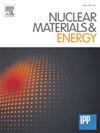Advanced materials to enhance the nuclear performances of the high temperature Dual Coolant Lithium lead breeding blanket for the EU DEMO
IF 2.7
2区 物理与天体物理
Q1 NUCLEAR SCIENCE & TECHNOLOGY
引用次数: 0
Abstract
The evolution of the Dual Coolant Lithium Lead (DCLL) Breeding Blanket (BB) in the EUROfusion framework has led to the implementation of a Single Module Segment (SMS) architecture whose particularity is that it introduces the use of ceramic channels through which the self-cooled breeder (PbLi) circulates, allowing for a High Temperature (HT) concept. Among other candidates, SiC was initially selected. This HT SMS concept has shown certain drawbacks from the neutronic point of view. In particular, it was observed that this concept led to a decrease of the Tritium Breeding Ratio (TBR) below the required value (1.15 for DEMO). In this study we propose the addition of a specific component behind the breeding zone that acts either as a neutron reflector or as a better shield against radiation, in order to recover the TBR in a direct or indirect manner. The use of ZrH2 is preferred for this purpose as it allows combining both effects. On the other hand, there was a certain risk that SiC could not withstand the mechanical loads, so other ceramics (ZrO2, SiO2 and MgAl2O4) have been considered and their neutronic behaviour has been analysed. The use of ZrO2 has shown the best results in comparison with the other proposed, as a TBR of 1.17 (or 1.15 with a revised DCLL model) was achieved and improved all the shielding responses. Lastly, two different ZrO2 compositions that include industrial impurities and additives have been analysed to characterize their radiological behaviour and classify the radioactive waste following the international regulations.
提高欧盟DEMO高温双冷却剂锂铅繁殖毯核性能的先进材料
EUROfusion框架中双冷却剂锂铅(DCLL)繁殖层(BB)的发展导致了单模块段(SMS)架构的实施,其特殊性在于它引入了陶瓷通道的使用,自冷增殖器(PbLi)通过陶瓷通道循环,从而实现了高温(HT)概念。在其他候选材料中,SiC最初被选中。从中子的角度来看,这种高温超导的概念已经显示出一定的缺陷。特别是,观察到这一概念导致氚繁殖比(TBR)低于所需值(DEMO为1.15)。在这项研究中,我们建议在繁殖区后面增加一个特定的组件,作为中子反射器或更好的屏蔽辐射,以便以直接或间接的方式恢复TBR。对于这个目的,ZrH2是首选的,因为它允许结合两种效果。另一方面,由于存在SiC无法承受机械载荷的风险,因此考虑了其他陶瓷(ZrO2, SiO2和MgAl2O4)并分析了它们的中子行为。ZrO2的使用效果最好,TBR达到1.17(修正DCLL模型的TBR为1.15),并改善了所有屏蔽响应。最后,分析了两种不同的ZrO2成分,包括工业杂质和添加剂,以表征其放射性行为,并根据国际规定对放射性废物进行分类。
本文章由计算机程序翻译,如有差异,请以英文原文为准。
求助全文
约1分钟内获得全文
求助全文
来源期刊

Nuclear Materials and Energy
Materials Science-Materials Science (miscellaneous)
CiteScore
3.70
自引率
15.40%
发文量
175
审稿时长
20 weeks
期刊介绍:
The open-access journal Nuclear Materials and Energy is devoted to the growing field of research for material application in the production of nuclear energy. Nuclear Materials and Energy publishes original research articles of up to 6 pages in length.
 求助内容:
求助内容: 应助结果提醒方式:
应助结果提醒方式:


